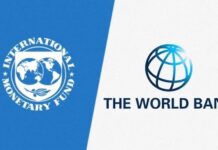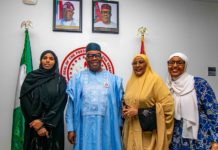This month Nicholas “Fink” Haysom ended a two-and-a-half year tour as the UN Secretary-General’s Special Envoy for Sudan and South Sudan and moved to Mogadishu to take up the job of the UN Secretary-General’s Special Representative to Somalia.
That might seem like going from the frying pan into the fire. But Haysom, (ever optimistic) is upbeat about the prospects of the country which will be his home (and his responsibility to help pacify) for the next few years.
In a recent interview in New York Haysom said “my Somali interlocutors assert that Somalia is on a much more positive trajectory than South Sudan. Some analysts agree. Over the last two or three years they’ve made steady progress in establishing a government, in formulating a governance agenda; in conducting something like elections – or what he calls “a political event with electoral features” rather than an election.
“They voted in a change of president. And they are making progress with the international financial institutions in regard to debt write-offs and gaining access to new concessionary loans.
“And they are insisting that in their interactions with the world they not be treated as simply a failed state, that their incremental progress be recognised.”
Haysom is not blind to the large challenges which Somalia still faces, not least the unfinished battle with the deadly al-Shabaab Islamist terrorist group. On 14 October the country commemorated the loss of 655 civilians exactly one year earlier in the IED blast in central Mogadishu- the largest destructive terror bomb blast in Africa.
The fact that he rates its prospects as better than those of South Sudan perhaps says more about the uncertain fate of South Sudan than it does about the chances for Somalia.
Even for South Sudan, though, Haysom is rather optimistic, though not without reservations.
He recalls that he started his assignment as special envoy to the two Sudans on 1 July 2016 and on 16 July the second phase of the country’s civil war erupted in the capital Juba, in a deadly showdown between the forces of President Salva Kiir and those of his old enemy, Vice President Riek Machar.
As he notes, Kiir’s armed forces pursued Machar right to the DRC border. “He set off for the border on foot,” and eventually made it into exile. Machar had only recently returned to Juba to take up his old position of vice president from which Kiir had fired him in 2013, helping to precipitate the first phase of the civil war in December 2013.
On 12 September this year, just days before Haysom was to leave his post as special envoy for the Sudans, yet another peace agreement was signed between Kiir, Machar and a broader range of South Sudanese political leaders.
This was the “Revitalised” Agreement on the Resolution of the Conflict in South Sudan. The original ARCISS as it is known, was signed by Kiir, Machar and others in August 2015. It envisaged a ceasefire, with Machar once again becoming vice president in a transitional government. It imploded soon after he returned to Juba.
After Machar fled what he asserted was a determined attempt to kill him in July 2016, he eventually found his way to South Africa where Pretoria later agreed to requests from leaders in the Horn of Africa (under the Intergovernmental Authority on Development. [IGAD]) to keep him under de facto house arrest. IGAD and South Africa’s thinking was that it would be possible to negotiate an end to the civil war if only Machar were out of the equation.
Haysom found this logic very puzzling. “For 18 months my office consistently pointed out that there couldn’t be a coherent peace process unless Machar participated.
“This was not because of any partisan sympathy for Machar but because Conflict Resolution 101 requires the major protagonists (to participate in negotiations) – which is what South Africa has always insisted was a necessary approach to conflict resolution.
“It was notable that when IGAD leaders finally accepted this, (and Machar was allowed to return from SA to participate in negotiations) they began to make rapid progress in the peace talks.
“The second aspect of our approach has been to accept and to support the notion that the region (IGAD) should take the lead in finding a solution.”
So Haysom says it is gratifying that as he leaves his post, after 15 months of negotiations conducted by IGAD, with Sudan and Uganda in the lead, the Revitalised ARCISS has been signed by Kiir, Machar and most of the other parties and a new framework for a transition has been launched.
This provides for a pre-transition of 8 months and a comprehensive transitional road map of three years, leading to new elections.
But he adds that “formidable challenges lie ahead” to make the peace agreement sustainable. Caution is well advised, considering that this is the third time that a government of national unity has been launched in a matter of a few years.
Haysom identifies four main conditions for sustainability. The first is inclusivity, both in who participates but also in the way the agreement is implemented. All sectors in South Sudan must be embraced by the peace agreement.
“The second issue is the security arrangements in which I think there are gaps, especially regarding how the cantonment exercise will work out,” Haysom says, referring to how soldiers from both sides are to be confined to their bases during the transition.
Another security issue is which international forces will fill the security gap during the transition when the South Sudanese soldiers are cantoned, this has not been agreed yet.
A third security question is whether all the parties have a shared understanding of how all the armed groups are to be merged into a unified army. “If they don’t have a meeting of the minds on how the assembling, separating and the unifying of armed forces will work out, it can be disastrous,” he says, citing Namibia and Zimbabwe as examples of where there were tragic misunderstandings.
Another condition is financial propriety, Haysom says. “There had been widely condemned plunder of public funds previously and so most of the donors are not prepared to put up the money to fund this implementation unless there are steps taken to effect accountability for past misappropriation.”
And the final issue is the enforceability of the agreement. The previous comprehensive peace agreement – of August 2015 -broke down in July 2016 because the government, among others could take the steps it wanted without any outside party insisting that they stuck to the agreement. “And the question which some South Sudanese are asking is what’s going to be different this time?
“ I have cautioned, that the IGAD leadership, the leadership of the region, has to take a much stronger, even intrusive role, in enforcing the agreement.” Haysom had just told the Security Council that the first step is to demonstrate political intent, political will to make the guns fall silent- immediately and everywhere.” Sadly there have already been sporadic violations of the ceasefire though not enough, it seems, to wreck the deal.
What gives Haysom greater hope for this peace agreement than for previous ones is the regional environment. “Across the Horn of Africa region, peace has broken out…”, he says. This has been prompted by new Ethiopian Prime Minister Abiy Ahmed’s rapprochement with his country’s old enemy and neighbour Eritrea.
Haysom said this reconciliation had had knock-on effects beyond these two countries. “People have now begun to re-engage in regard to their interstate conflicts which the international community had been told were intractable; such as Djibouti-Eritrea, Ethiopia-Eritrea; Somalia and Eritrea.”
The only caveat to his optimism is that the divisions in the Gulf (with Saudi Arabia and the United Arab Emirates pitted against Qatar) has spilled over into the Horn of Africa. This has been divisive as different Horn states or factions within states have been compelled to choose different sides in the Gulf stand-off.
That’s also true in Somalia, which still faces significant challenges despite some progress towards stability over the last few years.
These challenges include meeting its governance agenda which requires it to adopt a constitution and hold universal suffrage elections within the next two years. “For them to do that there has to be collaboration between the member states, the constituent parts of Somalia, and the Federal Government. And at the moment the relations between the two are frayed.”
He noted that three weeks before the sub-national states had taken a decision not to work with the federal government.
“Some of that is allegedly prompted by the rival sponsorship of the Federal government and the different states by rival Gulf countries.” When the Gulf schism happened, both sides expected Somalia to take their side but Somalia benefits from aid and support from both sides and asserted its neutrality.
“There are elements in Somalia, in parliament and in the federal member states, which challenge that neutrality.”
Haysom said Somalia needs to engage with the Gulf countries but they in turn must respect Somalia’s sovereignty. The federal government and the member states have to achieve their own consensus on how a federal Somalia will work, on the extent of autonomy of the member states and how to distribute government revenue among them.
There are also other conflict issues to manage such as the tense relationship between Somalia and the breakaway state of Somaliland, and the longstanding border conflict between Somaliland and Puntland.
At the same time, an “overriding issue is that Somalia is facing down Africa’s deadliest terrorist network (al-Shabaab) in an asymmetrical war.”
Somalia is strongly supported by an African Union peacekeeping force, Amisom, in its fight against al-Shabaab and Amisom in turn is being supported by the UN logistically and financially by Western donors.
Most observers agree that Amisom has generally done a good job, though Haysom suggests there are co-ordination challenges facing the Amisom components, the Somali forces and fragmented international supporters.
There is now broad agreement that Amisom should be reconfigured as Somalia’s own security forces build up, Haysom said, noting that tensions had arisen from trying to force the pace of the Amisom drawdown when the country was not yet ready to provide for its own security. “Al-Shabaab has been pushed out of Mogadishu and most of the other cities. However much of the countryside is controlled by al-Shabaab and it is still able to penetrate the urban areas.”
Haysom seems to agree with the AU complaint that Amisom needs greater technical military support to enable it to be more offensive. For a peacekeeping force, Amisom absorbs an extraordinarily high level of fatalities.
The Somalis have made progress against al-Shabaab, Haysom summarises. They’ve made progress in building governance and more recently in the economy. But Somalia still has a way to go. It will continue to need international support for its progress to become irreversible




